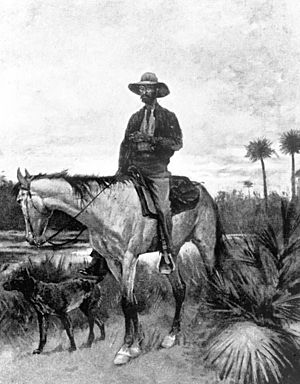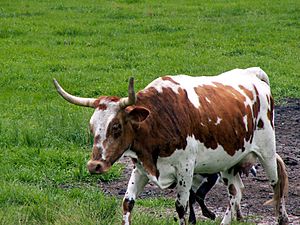Florida Cracker Horse facts for kids

An 1895 drawing by Frederic Remington of a Florida Cracker cowboy
|
|
| Distinguishing features | Spanish-style gaited horse found in many colors |
|---|---|
| Alternative names | Chickasaw Pony, Seminole Pony, Prairie Pony, Florida Horse, Florida Cow Pony, Grass Gut |
| Country of origin | United States |
| Breed standards | |
| Florida Cracker Horse Association | Breed standards |
| Horse (Equus ferus caballus) | |
The Florida Cracker Horse is a special type of horse from Florida, USA. It looks and acts a lot like other horses that came from Spain. These horses are known for being very quick and agile. They are also a gaited breed, which means they have extra smooth ways of moving.
Spanish explorers first brought horses to Florida in the early 1500s. These horses helped people herd cattle. Over time, they became the Florida Cracker Horse we know today. Florida cowboys, called "crackers," used these horses until the 1930s.
Later, bigger American Quarter Horses were needed for larger cattle. This caused the number of Florida Cracker Horses to drop a lot. Luckily, some families and the Florida government worked hard to save the breed. Even so, there are still not many of them left. Groups like The Livestock Conservancy and the Equus Survival Trust say the breed is in a "critical" state.
Contents
What Makes Them Special?
The Florida Cracker Horse has many names. Some people call them Chickasaw Ponies or Florida Cow Ponies. They are about 13.2 to 15 hands (54 to 60 inches, 137 to 152 cm) tall. This is similar to their Spanish ancestors. They usually weigh between 750 to 1,000 pounds (340 to 450 kg).
Colors and Looks
You will mostly see these horses in bay (brown), black, or gray. But they can also be grullo, dun, or chestnut (reddish-brown). Sometimes, you might even see roan or pinto colors. They have straight or slightly curved faces. Their backs are strong, and their rumps slope down.
Special Gaits
Florida Cracker Horses are famous for their speed and quickness. They are great for trail riding and endurance riding. They also work well as stock horses, helping with cattle. You might see them in Western riding sports too.
These horses are "gaited." This means they have special smooth ways of moving. Besides walking, trotting, cantering, and galloping, they have a running walk and an amble. Some fans call their unique ambling gait the "coon rack."
A Look at Their History
Horses first came to North America in 1521. Juan Ponce de León brought them on his second trip to Florida. These horses helped explorers and herders. More horses and cattle came with later Spanish trips. By the late 1500s, horses were very important for the cattle business.
How the Breed Developed
The horses brought by the Spanish were smaller. They had traits like short backs and wide foreheads. These included Barbs, Garranos, and Andalusians.
Early cattle drivers were called "crackers." This name came from the sound of their whips. The name then stuck to the horses they rode and the cattle they herded. These Spanish horses became the Florida Cracker Horse. They were known for being fast, strong, and agile. From the mid-1500s to the 1930s, they were the main horse in the southeastern USA.
During the American Civil War (1861–1865), Florida horses were popular. They were good riding horses. New Spanish horses from Cuba also came to Florida.
Facing Extinction
In the 1930s, during the Dust Bowl, large cattle from the west came to Florida. These cattle had a parasite called the screwworm. They needed frequent treatment. The Florida Cracker Horses were too small to handle these bigger cattle. Cowboys started using American Quarter Horses instead. This caused the Florida Cracker Horse breed to almost disappear.
Saving the Breed in the 20th Century
The Florida Cracker Horse survived thanks to a few families. They kept breeding these horses and saved their unique bloodlines. One such breeder was John Law Ayers. In 1984, he gave his purebred Cracker horses to the state of Florida.
The state used these horses to start three small herds. These herds were in Tallahassee, Withlacoochee State Forest, and Paynes Prairie State Preserve. By 1989, only these three herds and about 100 other horses owned by private families were left.
In 1989, the Florida Cracker Horse Association was formed. A registry was set up in 1991. Seventy-five "foundation horses" were registered right away. These horses came from four main Cracker bloodlines. By 2009, about 900 horses had been registered.
On July 1, 2008, the Florida House of Representatives made the Florida Cracker Horse the official state horse. Today, there are three main bloodlines. The state of Florida still keeps two groups of Ayers-line horses for breeding. They also have a display group at Paynes Prairie Preserve.
The breed is still considered "critical" by The Livestock Conservancy. This means there are fewer than 2,000 of them worldwide. Also, fewer than 200 new horses are registered each year in the US. The Equus Survival Trust also calls them "critical." This means there are only 100 to 300 active breeding mares. But the good news is, their numbers are slowly growing!
The Chickasaw Horse Connection
The original Chickasaw horse was bred by the Chickasaw Indians. They used horses captured from Hernando de Soto's trip. This breed later died out. But it helped create the Florida Cracker Horse. Some people still use the name Chickasaw to describe today's Florida Cracker Horses. In the 1970s, there was interest in bringing back the Chickasaw horse. However, that effort has since ended.



